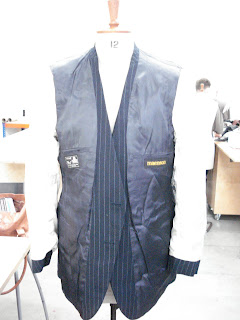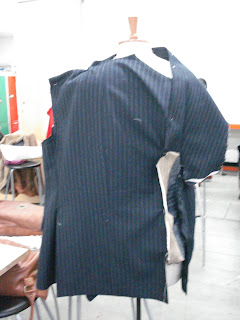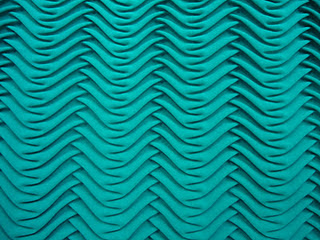After having brought my 2 tailored jackets- a Pin stripe and a plain one see below...
I then unpicked the linings of both as I didnt think they would add anything to my design.
unpicking a few seams leaving large peices in-tack like the sleeves and bodice and played with the peices on the manequin...
I liked the collar feature but the sleeves used as front panels were uninteresting and I thought could be used to create volume.
and so I unpinned it slightly letting out the sides a bit...but still didn't find it very effective.
I then decided to integrate more peices. For my final design I really wanted to make a feature with the shape of the arm hole as it holds and gives great structure. I got this idea of a 'hole' element from my Enlarged Paper form and draping ideas...
and related this into my designs...
Tryed to shape the 'hole' better...
...But analysing it from the side realised that it was to high and wouldnt flatter the body shape when worn
I wasnt happy with my back either, as it was too like the original jacket and needed to be altered or unpicked more.
I tryed on the jacket and whilst unpinning the top to get it on found it fell and draped into a nice shape to work with...
The side profile showed me that the 'hole' feature needed to be lowered, below the bust to become more flattering.
and pinned the back slightly diffrently...
continued in next post...
Sunday, 27 November 2011
Deciding on my wearable structure (week 10)
I had to make decisions about which techniques I wanted to take forward to make my 'Wearable Structure'.I felt my Glue and Mutton cloth outcomes created interesting siloutettes whilst my Enlarged Paper shapes generated unusual shapes.I would like to include both these qualities in my final structure. I enjoyed the technique and process of deconstruction when we joined two tailored jackets together. I found the challenge of creating something 'new' from something old and making the different fabrics work together very satisfying so will use deconstruction as my main technique.
A company that does just this is 'JUNKI STYLING', here are a few of their inspirational works...
With referance to the above and combining ideas from my Enlarged paper shapes, glue and mutton cloth with the technique of deconstruction created design ideas in pen and pencil...
Below combining the idea of 2 jackets, a pin stripe and a plain colour which I would like to use in my final design...
A company that does just this is 'JUNKI STYLING', here are a few of their inspirational works...
With referance to the above and combining ideas from my Enlarged paper shapes, glue and mutton cloth with the technique of deconstruction created design ideas in pen and pencil...
Below combining the idea of 2 jackets, a pin stripe and a plain colour which I would like to use in my final design...
Friday, 18 November 2011
'Draping' ( WEEK 9)
Firstly for this session we were taught how to make our own bodice out of callico to use as a foundation on which to then drape upon.
We then went on to the more exciting part...Draping! I first worked on the back of the mannequin using callico and then on the front. I looked back on previous work I had created and used these ideas as a referance point of inspiration. Exercises which I found generated the most insirational ideas for me was the Enlarged Paper Folding, Glue & Cloth and Suit Deconstruction. Here are some of my ideas...I felt that they were a success being 3Dimensional.
and some close ups of features/details I thought worked well...
We then went on to the more exciting part...Draping! I first worked on the back of the mannequin using callico and then on the front. I looked back on previous work I had created and used these ideas as a referance point of inspiration. Exercises which I found generated the most insirational ideas for me was the Enlarged Paper Folding, Glue & Cloth and Suit Deconstruction. Here are some of my ideas...I felt that they were a success being 3Dimensional.
and some close ups of features/details I thought worked well...
'Hand Pleating' (WEEK 8)
Terry Weinert from F CIMENT PLEATING LTD came in and showed us some of his work.
His company specialises in pleating and he's done work for Lady GaGa, Stricly Come Dancing to Cadburys.
Here are just a few of his amasing works:
To more intricate design...
Above is the original cardboard template made used to produce the blue pleated fabric below. Terry said that it can often take up to 80 hours to create a template. Once it is made the fabric is sandwiched between 2 of the same layers and steamed. He also noted that polyesters tend to work best as they keep their pleats better.
More Cardboard templates...
After his presentation of pleated fabrics, we were left to experiment to try and recreate pleats that we had seen and liked. I learnt the hard way by making mistakes but after contiuously playing eventually came up with the following...
I learnt that there are endless possibilitys to pleating, and it was really inspiring to think that these could be used for future garment ideas. It was very time consuming, yet very satisfying!!
Issey Miyake's unique and original design using paper pleating shows how the above techniques could be translated into a garment!
Or into architecture? As Cambridge Univeristy students did here for an architecture project.
His company specialises in pleating and he's done work for Lady GaGa, Stricly Come Dancing to Cadburys.
Here are just a few of his amasing works:
To more intricate design...
Above is the original cardboard template made used to produce the blue pleated fabric below. Terry said that it can often take up to 80 hours to create a template. Once it is made the fabric is sandwiched between 2 of the same layers and steamed. He also noted that polyesters tend to work best as they keep their pleats better.
More Cardboard templates...
After his presentation of pleated fabrics, we were left to experiment to try and recreate pleats that we had seen and liked. I learnt the hard way by making mistakes but after contiuously playing eventually came up with the following...
I learnt that there are endless possibilitys to pleating, and it was really inspiring to think that these could be used for future garment ideas. It was very time consuming, yet very satisfying!!
Issey Miyake's unique and original design using paper pleating shows how the above techniques could be translated into a garment!
Or into architecture? As Cambridge Univeristy students did here for an architecture project.
Subscribe to:
Posts (Atom)


























































